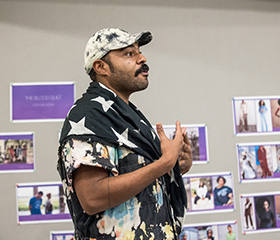In Katori Hall’s The Blood Quilt, in rehearsal for performances beginning October 30th, four sisters gather at their childhood home on an island off the coast of Georgia. Given the play’s title and the fact that the women are creating a quilt to honor their recently deceased mother, I couldn’t help asking Montana Levi Blanco, the production’s costume designer, how quilts might affect his approach to this undertaking.
Blanco, whose previous LCT work with director Liliana Blain-Cruz was The Skin of Our Teeth, for which he won a Tony, said that quilting would not be used directly for the characters’ costume designs. “There are clothing items that end up being incorporated into the quilt, but for the most part the aesthetic of what they wear is unrelated.”
According to Blanco, each woman has an individual way of dressing that reflects both her life and career path as well as the fact that they are half-sisters, sharing the same mother but each with a different father. “The eldest sister,” Blanco said, “is a midwife. She is the sister closest to the earth and to her ancestral past.” He added, “For her we may use a vintage look, pulled from a vintage store, while the clothing for the other women will probably be sourced online.”
Not only do the women’s professions differ – the second is a nurse, the third a police officer, and the youngest an entertainment lawyer in L.A. -- but so do their perspectives on their mother. Blanco said: “Each woman dresses in part to reflect a common heritage – race, gender, history – and each dresses to express an individuality related in part to the distance, both psychologically and geographically, she has traveled from her mother.”
Blanco has undergraduate degrees from Oberlin in oboe (Conservatory) and history (College). I am unequipped to analyze the way the former specialization inflects his work but as an undergraduate history major myself I can attest to the scholarly care Blanco brings to each assignment. The Blood Quilt is contemporary in unfolding while steeped in the Gullah-Geechee culture of its off-shore Georgia setting. Some of the inspiration imagery Blanco used for his creative process juxtaposes the modern-day look a character may wear with a historical black-and-white photo of a woman from these culturally rich islands.
“Closeness to ancestry,” Blanco said, “informs my thoughts about what these woman might wear. And I’m always helped by talking with the actors, to get a sense of how they see their characters.”
The design on view in The Blood Quilt may reflect a specific history and culture but Blanco said that there is a universality to the arc of the drama’s narrative. “The story asks what it means to gather as a family when the anchor of your world has gone. How does a family reinvent itself – how does it step forward? – in these circumstances? I think most people can relate in some way.”
Brendan Lemon is a freelance journalist in New York.
